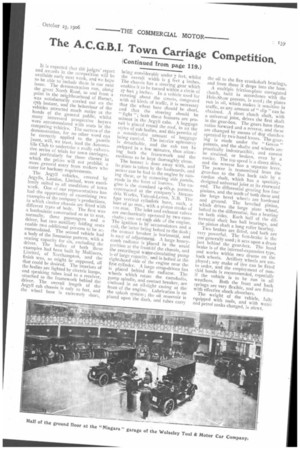The A.C.G.B.I. Town Carriage Competition.
Page 19

If you've noticed an error in this article please click here to report it so we can fix it.
Continued from page 119.)
It is expected that thik judges' report and awards in the competition will be available early next week, and we hope to be able to include them in our next issue. The demonstration run, along the great North Road, to and from a point in the neighbourhood of Barnet, was satisfactorily carried out on the 17th instant, and the behaviour of the vehicles attracted much notice at the hands of the general public, whilst many interested prospective buyers were accommodated with seats in the competing vehicles. The success of the demonstration, for no other word can be correctly applied to the 3o-mile jaunt, will, we trust, lead the Automobile Club to undertake a really exhaiNtiye series of trials for town carriages, and particularly for those classes in which the prices will not prohibit a more general entry from makers who cater for hackney requirements.
The Argyll vehicles, entered by Arg-ylls, London, Limited, were excellently suited to all conditions of town work. One of our representatives has had the opportunity of examining two examples of the company's productions, in which similar chassis are fitted with different types of body. The first was a landaulette constructed so as to seat, normally, three passengers and a driver, but two auxiliary folding seats enable two additional persons to be accommodated. The second vehicle had a body of the limousine pattern, with a seating capacity for six, excluding the driver. The bodies of both these examples had been built by MuMiters, Limited, of Northampton, and the finish was, as might be supposed, all that could be desired. The interiors of the bodies are lighted by electric lamps, and speaking tubes lead to a receiver, attached to the framework behind the driver. The overall length of the Argyll cab chassis is only TO feet, and the wheel base is extremely short, being considerably under 7 feet, whilst the overall width is 5 feet 4 inches. The chassis has a steering gear which enables it to he turned within a circle of 27 feet 3 inches. In a vehicle used for running about the streets, congested with all kinds of traffic, it is necessary that the wheel base should be short, and that the steering should be " light "; both these features are prominent in the Argyll cabs. A luggage rail is placed round the roof, in an the styles of cab bodies, and this permits of a considerable amount of baggage being carried. The interior upholstery is detachable, and the cab can be stripped in a few minutes, thus allowing both the framework and the cushions to be kept thoroughly clean.
The bonnet is done away with, and its place is taken by the footboards, and access can he had to the engine by raising these, or by removing side panels, made in the form of louvres. The engine is the standard 14-r6h.p. pattern, constructed at the company's Alexandria Works, Vale-of-Leven, N. B. The four vertical cylinders have, each, a bore of eo mm., with a piston stroke of 120 nun. The inlet and exhaust valves are mechanically operated by two camshafts ; one on each side of the engine. The ignition is by accumulators and a toil, the latter being bolted to the dash ;. the contact breaker is horizontal, and is efty of adjustment. A large honeycomb radiator is placed in the usual position at the front of the chassis, and the centrifugal water-circulating pump is of large capacity, and is bolted at the right-hand side of the engine near the first cylinder. A large strap-driven fan is placed behind the radiator. The wheels which rotate the camshafts, Rump spindle, and contact breaker, are enclosed in an oil-tight casing at the front of the engine. Lubrication is on the splash system ; the oil reservoir is placed upon the dash, and tubes carry
the oil to the five crankshaft bearings, and from these it drops into the base.
A multiple friction-plate corrugated clutch, built in accordance with the Hely-Shaw patents, is used ; the plates. run in oil, which makes it sensitive in traffic, as any amount of " slip " can be obtained. A short clutch shaft, with a universal joint, drives the first shaft in the gear-box. The gears have three ratios forward and a reverse, and these are changed by means of dog clutchei operated by two hand levers. The gearing is made under the " Govan " patents, and the shafts and wheels are practically indestructible, and cannot be strained, or broken, even by a novice. The top speed is a direct drive, and the reverse has a separate lever. The power is transmitted from the gear-box to the live back axle by a cardan shaft, which has a specially-designed universal joint at its rearward end. The differential gearing has four pinions, and the teeth of both these and the large bevel wheels are hardened and ground. The bevelled pinion, which drives the large plate wheel, bolted to the differential, has a bearing on both sides. Each half of the differential shaft has ball bearings, and the pinion shaft a long roller bearing.
Two brakes are fitted, and both are very powerful. The foot-brake is the one generally used ; it acts upon a drum just behind the gear-box. The hand brake is of the internal-expansion type, and works within two drums on the back wheels. Artillery wheels are employed; any make of tire can be fitted to order, and the employment of nonskid bands is recommended, especially if the vehicle is to be run in all weathers. Both the front and back springs are very flexible, and are fitted with effective shock. absorbers.
The weight of the vehicle, fully equipped with tools, and with water and petrol tanks charged, is 26cwt.
























